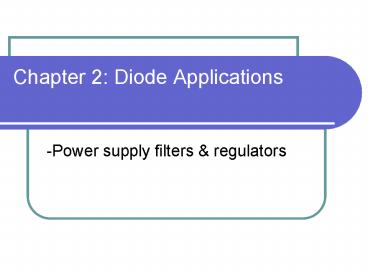Chapter 2: Diode Applications - PowerPoint PPT Presentation
1 / 26
Title:
Chapter 2: Diode Applications
Description:
Explain and analyze the operation and characteristics of power supply ... of diode limiters. Determine the output voltage of a biased limiter ... Limiters ... – PowerPoint PPT presentation
Number of Views:275
Avg rating:3.0/5.0
Title: Chapter 2: Diode Applications
1
Chapter 2 Diode Applications
- -Power supply filters regulators
2
Sub-Topic Objectives
- Explain and analyze the operation and
characteristics of power supply filters and
regulators - Explain the purpose of a filter
- Describe the capacitor-input filter
- Define ripple voltage calculate the ripple
factor - Discuss surge current voltage regulation
3
Power supply filtering
- Filter is a capacitor in a power supply used to
reduce the variation of the output voltage
rectifier
4
Capacitor-Input Filter
5
Ripple Voltage
- Ripple Voltage the small variation (undesirable)
in - the capacitor voltage due to the charging
- discharging of the filter capacitor
6
Comparison of ripple voltage
Full rectifier easier to filter because of the
shorter time between peaks (smaller ripple)
7
Ripple Factor
Ripple Factor (r) indication of filter
effectiveness (the lower
the ripple factor the better filter)
8
Example 7
Determine the ripple factor for the filtered
bridge rectifier with a load as indicated in
figure below
Answer 0.079 _at_ 7.9
9
Surge Current
- At the instant the switch is closed,
- voltage is connected to the bridge
- and the uncharged capacitor
- appears as a short.
- Produce ISurge through D1 D2
- ISurge could destroy the diodes
- RSurge used to prevent the diodes
- from destroy.
- RSurge lt RL
10
IC Regulators
- Combination of capacitor-input filter with
integrated circuit voltage regulator - Operation
- the input to the regulator is first filtered
with a capacitor to reduce the ripple tolt10 - The regulator reduce the ripple to a negligible
amount (acceptable level) - 3 terminals input, output and reference
11
Percent Regulation
- Line regulation specify how much change occurs in
the output voltage for a given change in input
voltage - Line regulation
- Load regulation specify how much change occurs in
the output voltage over a certain range of load
current values. - Load regulation
12
Chapter 2 Diode Applications
- -Clippers Clampers
13
Sub-Topic Objectives
- Explain and analyze the operation of diode
limiting clamping circuits - Explain the operation of diode limiters
- Determine the output voltage of a biased limiter
- Explain the operation of diodes clampers
14
Diode Limiters (Clippers)
- A diode network that have the ability to clip
(cut short/crop) off a portion on the input
signal without distorting the remaining part of
the alternating waveform. - Used to eliminate amplitude noise or to fabricate
new waveforms from an existing signal. - 2 general of clippers
- a) Series clippers
- b) Parallel clippers
- Series Clippers
- Diode is in series with the load.
- Parallel Clippers
- Diode in a branch parallel to the load.
15
Simple Series Clipper
- Diodes clip a portion of the AC wave.
- The diode clips any voltage that does not put
it in forward bias. - Any type of signals can be applied to a clipper
16
Analysis steps for series clipper
- Define the input and output port
- Determine the current flow of the circuit
- Determine the applied voltage (transition
voltage) that will result in a change of state
for the diode from the off to on state - Draw the output waveform directly below the
applied voltage using the same scales
17
Series clipper with dc supply
By adding a DC source to the circuit, the voltage
required to forward bias the diode can be changed.
18
Example 8
Determine the output waveform for the network
below
19
Simple Parallel Clipper
- By taking the output across the diode, the output
is now the voltage when the diode is not
conducting. - A DC source can also be added to change the
diodes required forward bias voltage
20
Example 9
Determine the Vo and sketch the output waveform
for the below network
21
Summary of Series Clippers
22
Summary of Parallel Clippers
23
Diode Clampers
- A clamper is a network constructed of a diode,
resistor, and a capacitor that shifts a waveform
to a different dc level without changing the
appearance of the applied signal
Positive clamper
24
Diode Clampers
Negative clamper
Application The clamping circuit is often used
in TV receivers as a dc
restorer
25
Example 10
Determine the output voltage waveform.
Assume that RC is large enough to prevent
significant capacitor discharge
26
Summary of Clampers































